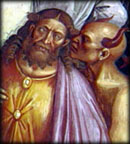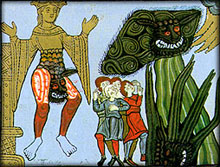|
|

The roots of the Antichrist idea go back to the Bible. In fact, in a sense
they go back to the Old Testament and the Book of Daniel. And they're
reinforced by certain passages in St. Paul, in the New Testament, and greatly
elaborated down the centuries, including quite early in the Middle Ages. The
idea was that Antichrist could be a human being, could be a man who would
incorporate everything that was opposed to the true Christ. And he would
deceive the world. He would be apparently very good, and would establish a
reign which seemed to be just and prosperous and so on. But this would all be
false pretense. It would all be a way of seducing mankind from the true
Christ. And then the true Christ would appear and annihilate him. And then
that would be the Second Coming. ...





The key figure to what [I] could call the coalescence of the Antichrist legend
is a monk of the 10th century named Adso, a French monk. And he
writes a famous letter on the Antichrist to the Queen of France, in which he
summarizes all the ancient traditions from the West about Antichrist. But he
does so in a very interesting form. He uses the form of a saint's life, a
saint's life in reverse. And I think we have to remember that saints' lives
were the movies of the 10th century. It was the most popular form
of literature. ... It was the form that Adso used which made his famous letter
on the Antichrist such a important document in the history of apocalypticism.
Hundreds of manuscripts of this survive, translations into vernaculars, etc.,
etc.

The Antichrist is not mentioned in the Book of Revelation. How at this time
does an idea about the Antichrist begin to form?
The term "Antichrist" doesn't occur in the Apocalypse. It only occurs in the
epistles ascribed to John in the New Testament. But nevertheless, the image ofx
the beast, particularly in the 13th chapter and later in the
17th chapter, was always interpreted as a symbol of Antichrist in
Christian tradition. Antichrist traditions then are very powerful throughout
the history of Christianity. What made Adso in the 10th century so
important is that you have an easy, comprehensible picture of Antichrist, his
whole life from birth to death, presented to a general audience, and if you
will, therefore solidified for popular appeal.





 |  |  |

signorelli's depiction of the antichrist as jesus' demonic twin
 |  |  |
There's been a very profound link between Antichrist belief and anti-semitism
historically. The origin of this, I think, is that the assumption was that the
Antichrist would be a demonic twin of Jesus, and the fact that Jesus was Jewish
gave rise to the conclusion that therefore the Antichrist will be a Jew. And
in medieval Europe we see close connections between apocalyptic belief and
belief in the Jews as demonic and sinister. So for example, when the Crusades
were getting underway and Christians were going off to Jerusalem to redeem the
city of Jerusalem from the heretics, at the same time we see horrible,
horrendous anti-semitic persecutions breaking out in some of the cities of
Germany, for example. There's a close connection in people's minds between the
sinister Jew and the Antichrist. And that theme continues really in prophetic
popularizations right down to the present. ...


Hildegard of Bingen is one of the most interesting figures in the whole history
of apocalypticism. A German abbess, obscure, but very brilliant, a very
talented, multi-talented woman, and a deep believer in Bible prophecy. And she
presented her vision, her understanding of the prophecies, in different media.
She wrote music. She created paintings in which she tried to capture the
visions she had had of the reign of the Antichrist and the Last Judgment. And
these really penetrated into European culture, in her own day and afterward.
...



Hildegard of Bingen is very significant because it reminds us that the history
of apocalyptic expectations is not just a male phenomenon in the history of
Christianity ... and her unique view of the theology of history and of the end
times, the picture that she has of the Antichrist, for example, as part of this
play or scenario, is one of the most inventive of the entire medieval
period.
 |  |  |

hildegard's birth of the antichrist
 |  |  |
Well, Hildegard of course gives us several pictures of the end times. But the
one that was most .. powerful, I think, is the picture in her book
Scivias, the visionary
book that she wrote in the 1140s. And this is a
series of visions, many of the connected with the heavenly world, but others
dealing with the course of history. One of these famous images is the picture
of the kingdoms of the end time and the birth of Antichrist from the Church.
This is a powerful image of a vast female figure representing the Church, with
this horrible monstrous head being born from the woman. And that of course is
the image of the Antichrist, who will be born from the Church, who will
persecute believing Christians, and who will try to pretend that he is divine
by ascending into heaven. And so in the image you have this monstrous head on
the top of a mountain, and then being cast down and destroyed by divine power
from above.

What is Scivias?
This was Hildegard's first great visionary work. And the term "scivias" means
"know the ways of the Lord." And Hildegard tells us that when she was 42 years
of age, she began to receive these visions and write them down, and then
explain them. Then the book was put together along with illustrations of the
visions that she had seen within her mind. And the Scivias can be
described as a kind of universal theology, talking about God's creation of the
world and the course of sacred history down to the end times. And it's within
that framework of a cosmology and history and eschatology that she presents her
unique picture of the Antichrist. ...

What role does Hildegard ascribe to Jews in her version of
Antichrist?
Hildegard, like many others, pondered the role of the Jews in the end times.
And often basing themselves upon Paul's prediction of the Jews returning to
Christ in the Book of Romans, many later commentators saw the Jews as coming
into the Christian fold at the end times. And I think that we have to put
Hildegard within the context of continuing Christian speculation about the role
of the Jews at the end period.

Does she associate the Jews particularly with the Antichrist?
No. For Hildegard, Antichrist is born from the Church. That's very crucial.
Because there are two traditions really in Christianity, at war with each other
for many, many centuries. One is that Antichrist will be born a Jew. The
other one is that no, he won't be a Jew; he will be born out of the Church. He
may convert the Jews briefly to himself, but many also believed that the Jews
then, even the ones who were converted to Antichrist, would repent before the
doomsday.

Is there a mirror image she sets up about the birth of Antichrist and the
birth of Christ?
I think that Hildegard taps into the very ancient tradition of what I would
call Antichristology. Just as in early Christianity the theological
speculation about who is Christ, what has he done, what are his powers, how
does he redeem, just as that developed in a very powerful way, as its opposite
side, we have the development of an Antichristology that adds onto the
scriptural data a whole history of the Antichrist and his powers and his
persecuting times. Hildegard continues that tradition in very powerful ways,
particularly of course by emphasizing how Antichrist will create a parody of
the great events of the end of Christ's life, that is, his death, resurrection,
ascension into heaven, and giving of the holy spirit. For Hildegard,
Antichrist will pretend to die ... and then, in a culminating moment, when he
tries to ascend into heaven and parody Christ's ascension, he'll be cast down
and destroyed. ...

home ·
apocalypticism ·
book of revelation ·
antichrist ·
chronology ·
roundtable ·
primary sources ·
discussion
readings ·
video ·
glossary ·
links ·
synopsis
web site copyright WGBH educational foundation
|